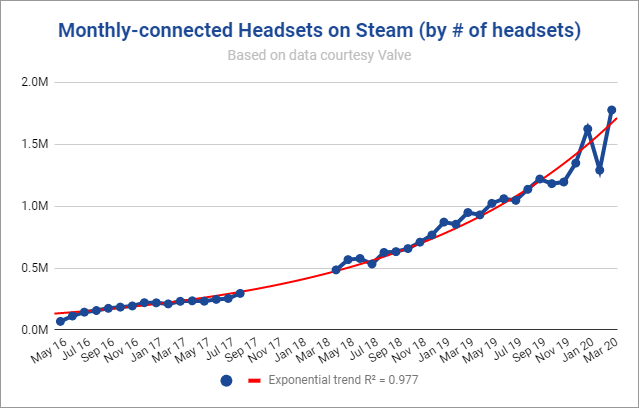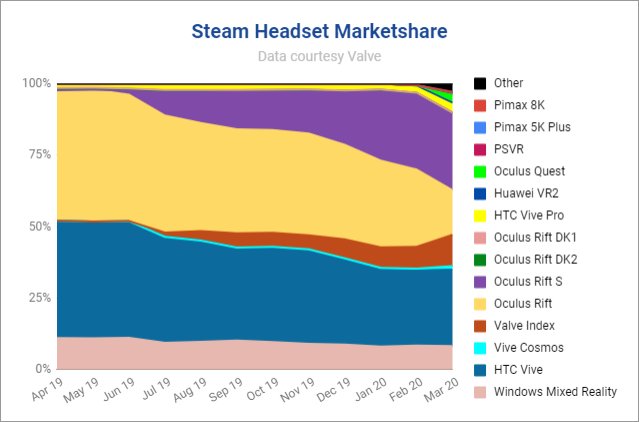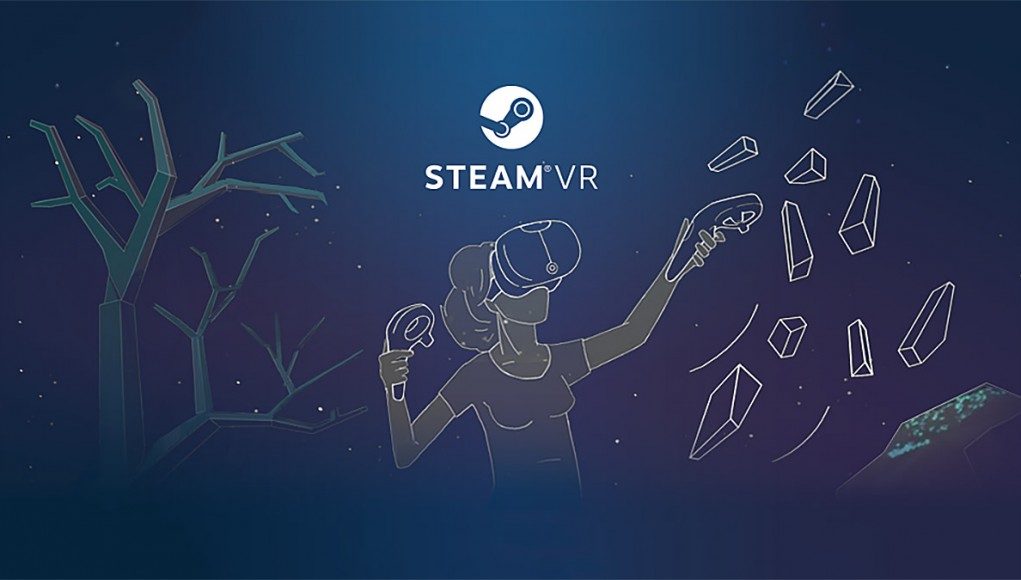The latest Steam Survey data became available this week, showing a record number of headsets in use on the platform as well as a surprising shift in the popularity of specific headsets.
That’s based on March 2020 data released this week from Valve’s Steam Survey. Each month the company collects info from Steam users to determine some baseline statistics about what kind of hardware and software is used by the platform’s population, and to see how things are changing over time.
This latest data is the first time we’re seeing the numbers since Valve revamped the Survey to collect more accurate information about which headsets are being used on Steam. In addition to revealing new headsets in the data for the first time—like Quest, Pimax, and PSVR—it also understandably brought a significant shift in the numbers from the prior month.
While the Steam Survey had previously only detected headsets that were connected to a user’s PC at the time of data submission, the new method stores information about any headsets connected to the PC in the last month and reports those headsets accordingly.
As the data represents the number of headsets connected to Steam over a given month, we call the resulting figure ‘monthly-connected headsets’ for clarity.
Monthly-connected VR Headsets on Steam
The latest figures from March show that 1.29% of Steam users had connected VR headsets to their PCs over the course of the collection period. That’s an increase of 0.28% over the previous month, but there’s two caveats here: first, we can’t be sure how much of that is attributed to actual growth vs. the change in data collection methodology, and second, Valve advised that most of the Survey data is collected in the first few days of each month, meaning that we won’t see most of the impact from the release of Half-Life: Alyx (which came later in the month) until the next set of survey data.
 The data shows a bit of chaos surrounding the change in collection methodology, but either way, it’s the next data point in a trend which has been stepping upward on average. To put the number into perspective, the latest Survey data also shows that 0.87% of Steam’s population is using Linux and 3.80% is using MacOS.
The data shows a bit of chaos surrounding the change in collection methodology, but either way, it’s the next data point in a trend which has been stepping upward on average. To put the number into perspective, the latest Survey data also shows that 0.87% of Steam’s population is using Linux and 3.80% is using MacOS.
While Valve’s data is a useful way see which headsets are most popular on Steam, the trend of monthly-connected headsets has always been obfuscated because the data points are exclusively given as percentages relative to Steam’s population—which itself is an unstated and constantly fluctuating figure.
To demystify the data, Road to VR has created a model based on the historical data, along with official data points directly from Valve and Steam, which corrects for Steam’s changing population to estimate the actual count—not the percent—of headsets being used on Steam.
While the percent of Steam users using VR headsets didn’t reach its highest point in March, our model estimates that March saw the greatest count of monthly-connected headsets to date.
 With more accurate information from Valve, our latest estimate of the number of monthly-connected headsets on Steam stands at 1.77 million. That’s a sizeable leap, and though we can’t be sure how much of the change is from real growth rather than the change in collection methodology, it’s a record high number for monthly-connected headsets on the platform. If the current trend continues, we expect to see some 3 million monthly-connected headsets on Steam around January 2021.
With more accurate information from Valve, our latest estimate of the number of monthly-connected headsets on Steam stands at 1.77 million. That’s a sizeable leap, and though we can’t be sure how much of the change is from real growth rather than the change in collection methodology, it’s a record high number for monthly-connected headsets on the platform. If the current trend continues, we expect to see some 3 million monthly-connected headsets on Steam around January 2021.
Share of VR Headsets on Steam
As for the share of individual headsets on Steam, things got understandably jostled around, including the introduction of headsets previously not shown in the Survey. Valve says the changes offer a more accurate picture of headsets in use on the platform, so here’s what we now know:
- Valve’s Index has surpassed all WMR headsets in use on Steam (10.94% vs. 8.28%)
- Oculus Quest has surpassed Vive Cosmos (2.89% vs. 1.25%)
- Oculus Rift S is the single most popular headset in use on Steam, surpassing the original HTC Vive (27.05% vs. 26.67%)
- Oculus Rift (CV1) was overrepresented in earlier data; collectively all consumer Oculus headsets now account for 45.50% on Steam (53.73% previously)
 Lesser-used headsets are also now showing in the data. Coming in at less than 1% of the share of headsets on Steam is Pimax 5K Plus, Pimax 8K, and even Playstation VR (which is not officially compatible with Steam but enabled via some third-party workarounds). There’s also 2.91% of “other” headsets shown, presumably a range of lesser-known and likely even misidentified headsets.
Lesser-used headsets are also now showing in the data. Coming in at less than 1% of the share of headsets on Steam is Pimax 5K Plus, Pimax 8K, and even Playstation VR (which is not officially compatible with Steam but enabled via some third-party workarounds). There’s also 2.91% of “other” headsets shown, presumably a range of lesser-known and likely even misidentified headsets.
As ever, it’s worth noting that the Steam Survey only gives us a glimpse of the overall VR market, as it only counts headsets connected to Steam. That means it doesn’t count some portion of Rift users which may not use Steam at all, nor other major headsets like PlayStation VR on PS4 and Quest standalone.







